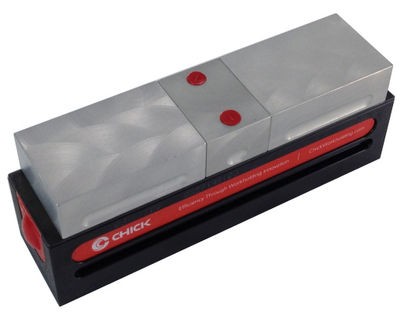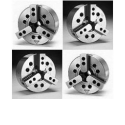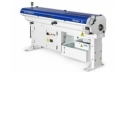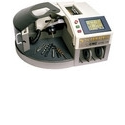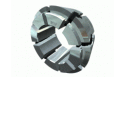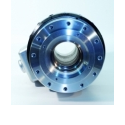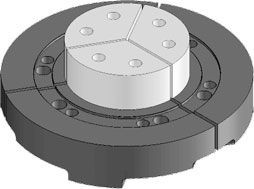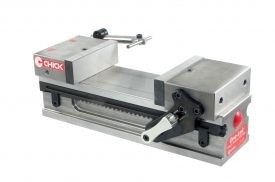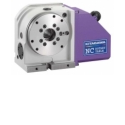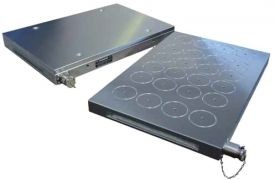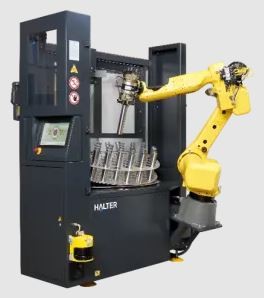1st Machine Tool Accessories Ltd
At 1st Machine Tool Accessories, we provide a one-stop shop for all your workholding and machining requirements. We only stock the best items from top manufacturers. We pride ourselves in providing our customers with peace of mind and satisfaction.
We stock a fantastic range of workholding and machine tool accessories, including clamping equipment, chuck jaws, machine vices, and precision machine mounts. We also stock larger items required with production machining processes, including rotary tables suited for all manner of application and the widest range of bar feeders on the market.
-
New workholding systems improve productivity and versatility
13 August 2019When Chick Workholding in the USA launched its One-Lok clamping system seven years ago as an alternative to the conventional machine vice, it introduced more precise workpiece positioning and a time-saving ratchet mechanism to adjust the position of the moveable jaw quickly. New lightweight versions have now been introduced to be marketed alongside it, offering users additional benefits. Availability in the UK is through sole agent, 1st Machine Tool Accessories, Salisbury (www.1mta.com)
The latest One-Lok is available in two sizes rather than one, 400 mm or 500 mm long, offering maximum gripping lengths of 180 mm and 280 mm respectively. Further improvements include a lowering of the clamp profile from 150 mm to 134 mm, which allows longer spindle travel in the Z-axis and also approximately halves the unit's weight for easier handling. To this end, an ergonomic handgrip has also been added at either end.
Sometimes, machinists turn a vice through 90 degrees so that it lies transversely across the machine table. This can bring the part closer to the operator, but has the disadvantage that there is no clearance for the handle. With the new One-Lok, workholding in this orientation, although there is little need, has been made easier by use of a ratchet handle.
The moveable jaw can be adjusted quickly and conveniently, as it can now be slid using one hand rather than two over the QwikSlide ratchets. A few turns of the handle move the jaw in the same direction over the last few millimetres to complete the clamping action rapidly.
The existing BoltFast interface for the 152 mm wide, interchangeable hard and stepped steel jaws and aluminium soft jaws has been retained. A quarter turn of the locking screw is all that is required to exchange them, promoting productivity when machining small batches of components.
As before, machining accuracy is enhanced by the enclosed design, which discourages swarf from accumulating, and by the mechanism's novel squeeze clamping action, which applies an equal and opposite force to both jaws and offers 20-micron repeatability. It provides virtually deflection-free component clamping with a maximum retaining force of 26.7 kN. On closure, the jaws impart a pull-down action to the workpiece for added security and precision.
Workholding evangelist, Paul Swann, owner and president of Chick said, "With CNC plant costing six figures, you do not want it standing idle while an operator winds a traditional vice handle up to 70 times to secure a part.
"It is important to remember that production efficiency when machining small batches is driven by the operator loading and unloading the parts, rather than by the machine itself.
“In developing the new, lightweight One-Lok design in two variants, we took on board comments from many of the thousands of people using the original model.
"So customers buying the new type can expect enhanced functionality and even faster payback, typically three months in an average job shop, based on increased output from expensive machine tools."
-
MACH 2016 preview information
11 March 2016
WIDE RANGE OF WORKHOLDING AND AUTOMATION SOLUTIONS WITH BESPOKE OPTIONS
Workholding, drill sharpening and automation equipment specialist, 1st Machine Tool Accessories (1st MTA), will show its extensive range of products for raising production output and maximising return on investment from machine tools.
A theme of this year’s stand will be the company’s ability to provide an array of customised solutions, allowing the company to justify its 2016 slogan, “The Answer’s Yes”, irrespective of the question a manufacturer asks.
Such bespoke equipment can solve complex production problems or, in standard applications, reduce set-up and idle times further. The results are extra versatility, fewer clampings, and higher levels of efficiency, accuracy and repeatability.
Prismatic machining
MAGNETIC WORKHOLDING AND MATERIALS HANDLING
Shown for the first time at MACH 2016 will be new range of Italian-made products that incorporate permanent-electro magnets, designed for workholding on machine tools and for handling sheet, bar and other ferrous materials in warehouses and factories. It follows 1st MTA’s appointment last year as UK and Irish agent for the equipment manufacturer, Tecnomagnete spa.
Items in the product range likely to be of particular interest include the MillTec Grip magnetic clamping system for milling machines and machining centres. The low-profile, frameless, monolithic clamps have a sealed, double magnetic circuit that allows uniform clamping between the workpiece and the magnetic surface and at the same time between the magnetic system and the machine table.
Emphasis will be placed on solutions for 5-axis and 5-sided metalcutting applications. Five sides of a component are freely accessible for milling and drilling and the light weight of the clamping system means that heavier components can be processed for a given maximum table load.
For added versatility, the workpiece can be raised from the working surface by a steel block carrying the MillTEC module. It is then possible to address machining around the periphery of the sixth side if the component overhangs the plate. It also gives more clearance for the spindle to facilitate machining of the four adjacent sides using shorter tools to minimise vibration.
Flexibility is further extended by the option to use reference dowel pins. These may be employed for accurate, repeatable, off-line fixturing of components on pallets used in multi-pallet machining cells. They also enable fixturing of non-magnetic components such as aluminium, brass and composite, as well as any awkwardly shaped part, in conventional fixtures.
For grinding applications, TFP and TPF magnetic clamping systems offer advantages, not least the variable magnetic pull-down force to suit the workpiece. The ability to remove residual magnetism from the component after machining prevents build-up of grinding dust on the surfaces and consequently the need for its time-consuming removal.
Worthy of special mention in the work handling section of the catalogue is the patented MaxX range of manually controlled lifters, which contain high-energy magnets capable of lifting loads up to two tonnes. The monoblock body improves safety by avoiding the need for separate sections bolted together. The flux remains entirely within the body until the handle is pulled to activate the lower surface of the lifter. Any metal object near the sides does not lessen the magnetic force, resulting in secure handling.
FLEXIBLE AND FAST-ACTING WORKHOLDING
The US workholding system manufacturer, Chick, represented in the UK by 1st MTA, offers a number of versatile solutions for clamping products quickly on machining centres. For example, an Indexing Sub System (ISS) will be demonstrated to show how it is able to present more components to a spindle by adding a fourth axis, a configuration that has the potential to increase a manufacturer’s profitability enormously.
The system on a vertical machining centre typically comprises four Chick Qwik-Lok twin-station workholding units mounted on the faces of a Multi-Lok square section column held horizontally between a rotary indexing table and a tailstock clamped to the machine table. On a horizontal-spindle centre, the Multi-Lok is clamped to the rotary table.
In this way, a minimum of eight components can be milled and drilled in a single CNC program, while if machined soft jaws are used, many more can be presented to the spindle, resulting in fewer tool changes per component and even more efficient production.
Another Chick product on show, which is a direct replacement for the old-fashioned wind-up vice, is the One-Lok clamping system, as will be explained on the stand. Unlike a traditional vice, which requires up to 70 complete revolutions of the operating handle to be fully opened or closed, One-Lok features a ‘QwikSlide’ mechanism that allows the moveable jaw to be easily unlocked and slid forwards or backwards to within a few turns of full closure, greatly speeding workpiece set-ups.
Its maximum grip capacity of 17 in (432 mm) is complemented by the manufacturer's ‘Boltfast’ jaw system, which enables jaws to be replaced quickly and efficiently with a repeatability of 0.02 mm. The system’s compact, modular design also features innovative ‘squeeze’ clamping, which imparts a pull down action and virtually deflection-free clamping with a maximum retaining force of 4.5 tonnes.
ROTARY TABLES
On show from Kitagawa will be a representative selection of the Japanese manufacturer’s rotary tables. A new model on the stand will be will be the Kitagawa TT150 tilting type rotary table with 150 mm faceplate and MAC mini controller for providing 4th and 5th NC axes on a machining centre.
High clamping torques, extreme rigidity and fast operation are key features of Kitagawa’s heavy duty GT series. Available in three models with tables from 200 to 320 mm diameter, the units incorporate a novel piston design that delivers component clamping torques of up to 2,800 Nm.
Productivity is further enhanced by the tables’ rigid yet compact design, which allows maximum metal removal rates to be combined with high indexing accuracy and repeatability. The series also features a rapid clamping action for reduced cycle times and maximum production throughput.
At just 99 mm deep, the body of the Kitagawa CK160 NC rotary table has a smaller footprint than any other model on the market. The ultra-compact 4th axis is suited to mounting on the table of a BT30-taper machining centre and provides manufacturers with a larger working envelope on any size of machine.
The CK160 is offered with a built-in rotary joint, in which case it is designated CKR160. A conventional table would typically measure half as much again from the face plate to the back. The rotary joint, which has seven ports for pneumatic and hydraulic supplies, allows the unit to operate on the C-axis of a 4-axis machining centre. Indexing accuracy is 20 arc seconds, with 4 arc seconds repeatability.
Rotational machining
EXTENDED RANGE OF COLLET CHUCKS
An extended range of collet chucks from Kitagawa will be exhibited, including standard short and long chucks and quick-change variants. Pull-back types, designated DHP, provide secure and accurate clamping of components and generate a powerful holding action for first-operation work. Other models like the fixed-length DHF range feature a removable bore stop, fixed collet position and high accuracy to ensure precise second-operation machining.
All chuck mounts suit a wide range machine tool types and have been designed to be both compatible and quickly interchangeable with other quick change collet clamping heads, without the need for special adaptors. The lightweight units are a good choice if a lathe spindle has a low maximum allowable weight based on its bearing load capacity and collet chucks are also popular for applications involving high spindle speeds.
Moreover, such chucks apply clamping force all around the circumference of a part instead of at a few contact areas, leading to tight concentricity. This can be particularly significant for second-operation work where accuracy relative to the first operation is needed to avoid tolerance build-up. Collets also open and close faster and can be exchanged more quickly than jaws, boosting productivity for both long and short runs.

